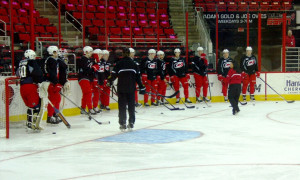
Peter Koutroumpis – editor@trianglesportsnet.com
RALEIGH, N.C. – Kim Muir knew what to expect when she led the second on-ice session of Carolina Hurricanes Prospect Camp at PNC Arena on Wednesday.
Though the power skating instructor is based out of the Plymouth, Mich. area, her work with the organization is not new as she led sessions during last year’s camp and has worked with the team’s AHL affiliate, the Charlotte Checkers, on numerous occasions in recent years.
It’s been productive for numerous younger players in the Hurricanes system who have improved their skating not only in the offseason, but during the year when able to mix it in with regular practice times.
“The more often you do anything, you’re gonna’ be better at it,” Muir said.
“Obviously the younger you start, the better you’re gonna’ be. It’s never too late as long as they want it. But you can’t do it like once a month. It would have to be pretty consistent – at least twice a week.”
After leading two sessions, one with all defensemen together and the other with the forwards, her detailed and regimented drills provided an interesting and spot-on summary of what took place on the ice for close to three hours.
According to Muir, the defensemen focused more on getting the drills and techniques right and went through their paces to get it right while the forwards had the mentality of trying to get the repetitions done as quickly as possible.
It was a very cogent assessment of hockey player mentality.
“There is a difference in that forwards are usually high-tempo, super-fast, more about doing the drill as opposed to methodically doing it correct,” Muir said.
“They wanna’ be first always. They wanna’ be fast. Defensemen are usually more methodical, a little more analytical about the game, the position. They’re usually not as talkative on the ice – a difference of personalities.”
Her points were indeed accurate as the number of times that Muir had to repeat herself to ensure the players executed the drills correctly was markedly increased when the enthusiastic and talkative forwards took to the ice as compared to the more cerebral defensive group.
For Muir, the two best pupils in each session were forward Brent Pedersen and defenseman Josh Wesley.
“Just solid, smooth, controlled,” Muir said of Pedersen’s skating.
“You’re not just looking for the super-fast one, but you’re also looking for the transitional one.”
“For the defensemen, I’d probably say Josh Wesley,” Muir continued.
“Josh skated with me all year long which helps out. He knows all my drills.”
Another gem that Muir offered on the importance of continued power skating work to be incorporated into a pro player’s development was that of using it to enhance their skating skill set beyond their position.
“At the highest level, to teach just basic forward skating or backward skating, stopping and starting, that’s not what they’re doing in a game,” Muir stated.
“There’s a lot of creativity going on – body position, puck control – it all goes together. There’s not just skating and skating for the game. Hopefully, when I’m out there, they see that it’s purposeful for the game, for their position. That’s the reason we always try to employ a two-way player, not just a forward to be a forward, and D to be a D. You wanna’ make yourself marketable; be that person that can step in at any given time for any given team.”
If any player in this year’s group of prospects truly paid attention to what they were doing, and understood why they were doing it, then they would have realized that they had just received one of the most important lessons in their career, and one that could make the difference in them ever making it onto the ice in the NHL or not.
Only time will tell to see how many actually did.
